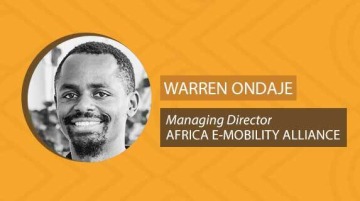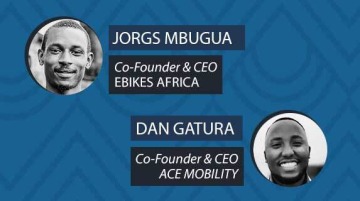
Ride-hailing in Africa has long been dominated by global giants like Uber and Bolt—especially in Kenya, East Africa’s tech innovation hub.
But as the electric vehicle movement gathers momentum, a new wave of local startups is emerging to tackle urban mobility challenges with homegrown, sustainable solutions.
In this episode of The Africa EV Show, we spotlight Kijani Boda, a Nairobi-based electric ride-hailing startup working to transform urban transport through electric two-wheelers. Founder Kimani Wa Ngugi shares insights into the company’s strategy to carve out space in a market ruled by global players, including how Kijani Boda leverages local e-bike assembly and Internet of Things (IoT) technology to enhance efficiency and user experience.
The conversation also explores how the company aligns with Kenya’s evolving EV policies, navigates regulatory hurdles, and builds toward a long-term vision of clean, accessible mobility for all.
Show Notes:
- Mobisoft: Motorbike hailing and on-demand courier solution for Kenya
- Rest of World: The little ride-hailing app that could catch up to Uber and Bolt in Kenya by Damilare Dosunmu
- Report: Ride Hailing Survey: Usage of App-Based Mobility Services in Nairobi, Kenya
About Kimani Wa Ngugi:

As the Founder and CEO of Kijani Boda, Kimani Ngugi is driving the future of sustainable transportation in East Africa. Recognizing the potential of electric mobility to revolutionize ride-hailing and empower communities while driving EV adoption, he established Kijani Boda as a platform connecting riders with eco-friendly electric motorcycles. With a vision for cleaner cities and enhanced economic opportunities, Kimani is leading Kijani Boda in building a greener, more efficient, and accessible transportation network across the region.
Transcript:
NJENGA HAKEENAH: Welcome to another episode of The Africa EV Show where we explore the bold new ideas shaping the future of mobility and energy in the Global South. Today, we are zooming in on Kenya’s ride-hailing sector, not through the usual suspects like Uber and Bolt, but through the lens of a new tech startup betting big on one thing, electric two-wheelers, most of which are powered by Chinese EV tech.
Now, in a market dominated by legacy players headquartered in Western capitals and expensive to maintain internal combustion engines, this startup is taking a radically different approach.
They are leveraging the flood of affordable e-bikes and building a platform that promises to lower costs for riders and drivers alike, all while reshaping urban transport from the ground up. We’ll dive into their entry strategy, unpack how local e-bike assembly and IOT integration are helping them grow, and look at how policy, performance metrics, and energy infrastructure are aligning to support Kenya’s green mobility future.
So how does an all-electric platform take on Uber and Bolt and win?
Let’s find out, and to help us do this is Kimani Wa Ngugi, the founder of Kijani Boda.
Welcome Kimani, it is very good to have you today.
KIMANI WA NGUGI: Thank you Njenga. Good morning and thank you for having me on the platform. My name is Kimani Wa Ngugi, founder and CEO of Kijani Boda, an EV platform, ride-hailing platform, based right in Nairobi, Kenya. So the goal is to leverage EVs to push adoption of electric mobility in Kenya, which aligns with Kenya’s vision of being a frontrunner in the EV space in Africa.
NJENGA: And indeed Kenya is a frontrunner, but let’s start by asking how old Kijani Boda is and the inspiration behind its founding.
KIMANI: Kijani Boda is three years old. We started in 2022, we’ve been building the app. So to push out the MVP means we have to refine the process over and over to make sure that we put out our co-product, the users, who are primarily of course the riders and the passengers.
So we saw the opportunity when one of the players exited the market in 2020. So and to set ourselves apart, we decided to go electric, which of course works well for our bottom line. Makes sense to go that direction because maintaining EVs is much cheaper compared to their ICE counterparts and of course powering them is also cheaper.
So for the bottom line, for the business, it’s very good for us.
NJENGA: It’s an interesting approach that I have seen that you have an incentive for new drivers where they get 30 days commission free. How is this working so far?
KIMANI: Oh, the reception has been great. So the drivers we’ve been in contact with have been very, very excited because the one thing, the fact that now we are separating the ICE riders from the EV riders makes them feel like now they are part of a community that has a common goal, right? So being like an electric community means that they have enough where they can call home, right?
So it’s been very exciting, of course, for us as well as a business and for them. And to see that kind of reception means that we are actually on to something.
NJENGA: I want to just build on that and ask about your entry strategy into the market where Uber and Bolt have established themselves as the dominant players. And apart from the incentives that you’re giving the new riders, what else are you targeting to make sure that you manage to get this business? Because we know that you’re competing with the big boys and they have the money to splash around, you know, cut prices to zero if need be.
KIMANI: No, so I get what you’re saying. So our strategy really is to push this as a homegrown app, which it is, right? So this is made in Kenya for Kenyans and by Kenyans.
So having something of our own means that we are not going anywhere, no matter what happens, right? These big players can exit at any moment because they are not really a Kenyan company. They are just here to do business.
So if they wake up tomorrow and say, you know what, the Kenyan market is not working for us, they just leave. But we are here to stay because we care for our country. We want to build jobs here.
We want to pay taxes here. So building this as a product for our home and indeed for the region, because we plan to expand, means that we are invested here. So this is a product for us, by us.
And we are here in the long run. So that’s one of our major marketing strategies.
NJENGA: Alright, that it is an African solution by Africans for Africa. But then these guys are expanding. He says they are expanding.
And so how does your platform leverage the availability of e-bikes to lower the cost of transport for Kenyan riders and drivers? And this is bearing in mind that the Kenyan consumer is very price sensitive.
KIMANI: Absolutely. So I’m sure you know that EVs are cheaper to maintain, cheaper to power, which means now our pricing has to be lower when we factor that in. So now we are looking as a ride-hailing app, we have to look on both ends.
One, the riders. So we make sure that our commissions are low, which means now that they end up making more money. And for the passengers, our pricing is very competitive.
Actually, I think 20% lower than the other players in the market. So as far as pricing is concerned, I think we have locked that in.
NJENGA: So it’s all on, you know, the customer saving more. And in your case, the customer is the rider and the driver. Now, as an on electric transport service provider, how are you working directly with e-bike manufacturers and local assemblers to integrate this low-cost e-bikes solution into your fleet?
And how does that influence your unit economics compared to your competitors, Uber and Bolt?
KIMANI: Great question. So right now, there are four major players in the EV space who are manufacturing locally, and that’s a good thing. So the first entrant was Rome.
We have Arc Ride, Ampersand from Rwanda, and Spiro. And they are all set up manufacturing bases here in Kenya, which means access is available locally. And that means that even maintenance is not a hassle for our drivers, right?
So partnering with these guys means that you don’t have to go through all that process of importing EV bikes. So currently, we are working on a contract with one of the manufacturers to have our riders acquire these bikes on our pay-as-you-earn model, which means now we’ll have an exclusivity with our drivers on our ride-hailing platform.
NJENGA: I’ve heard of many pay-as-you-earn and go plans and in this sector, because we also look at the buyer power in Kenya and most of these people who are involved in ride-hailing are people whose economies are limited in terms of like the finances. And so this partnership could be something that earns you the business and makes it an attractive feature or optional offering for the riders and also for the consumers, because the more bikes we have which are electric, the better.
KIMANI: Yes, the better it is for us as well.
NJENGA: Now, what are the specific features or performance benchmarks from e-bikes that you look at when you’re recruiting these guys or when you’re partnering with the assembler that you just mentioned? And how does this help your vehicle selection and service design?
KIMANI: So the first thing we have to look at is range. Range is very important because these guys are in business. So they need to run for as long as possible without having to charge again.
But the second thing is the network that the manufacturer has for battery swapping infrastructure, right? So that means that the guys we partner with, if they have enough battery swapping stations, that means that business, there’s continuity in business. So we have to factor that in.
For example, I’ll bring up one of the manufacturers, Arc Ride. They have a fantastic network in Nairobi of battery swap stations. So we are looking into a partnership with those guys because that makes a lot of sense.
Ampersand too, they have networks across the city and they are building more. So that’s something we are looking at keenly.
NJENGA: And I think like when you talk about range, I know, because I have been able to sample a number of these bikes or speak with people who are producing these bikes, like Kiri EV, for instance, their bikes can do 160 because they can accommodate two batteries. Then we have the bikes that can have one battery, which is like 80 kilometer range. And what is the basic number of kilometres a rider at Kijani Boda does in a day?
KIMANI: In a day, we have the average battery swap being three times. And this battery that they are swapping covers a range of 80 kilometres, right? The average driver covers 240 kilometres in a day.
So that means they have to swap their batteries three times a day. So the range is 80 kilometres or fully charged battery. So again, having battery swap stations available in the city makes business so much easier.
NJENGA: Because they don’t have to wait to charge. You’re swapping because all these things are integrated. How are you handling the integration of IoT and telematics in the e-bikes to ensure safety for the riders and for the drivers themselves?
And then in terms of tracking the bikes and also in terms of fleet optimisation on your platform?
KIMANI: So I can speak on IoT and telematics. From my end as a ride-hailing app, what I can say is we have tracking through GPS for riders during the trip. So basically, we do this for safety purposes, right?
And of course, recording the trip to send the details later to both the driver and the customer. So that is a requirement, by the way, by the Office of the Data Protection Commissioner in Kenya. So that has to be in place.
But primarily, we do that for safety of the driver and the passenger.
NJENGA: And then this ties in with the rising interest in clean energy transport. And I know you’ve mentioned the Office of the Data Protection in Kenya. But how are you aligning your platform with Kenya’s EV policies or partnerships with government and other private power providers?
KIMANI: Right. So Kenya’s policy on EV is about being a leader in EV adoption on the continent. So having a ride-hailing app, which primarily focuses on electric mobility means we are aligned with this vision.
So we see a space where adoption will pick up over time, because what we are doing is proving that the business works. So the driver gets to make more compared to the guy operating the ice bike, right? So a long term goal is to drive adoption of EV bikes.
And it’s also a climate play. But apart from being a climate play, I mean, it’s good for the economy. And it’s going to create sustainable and long term jobs.
NJENGA: And then when we talk about challenges, by the way, regulatory or logistical challenges that you face, what are these when it comes to recruiting e-bikes for commercial ride-hailing use?
KIMANI: So on the regulation front, we are dealing with the National Transport and Safety Authority in Kenya, which we call the NTSA. So the first challenge we faced when getting into the space was applying for a license. It’s called a Transport Network Operator License.
So you can imagine for a startup like us, forking out 100,000 Kenya shillings right out of the gate was quite a stretch, right? So but I mean, for the bigger players like Uber and Bolt, that’s just pocket change. But we’re not complaining because we understand the need to have regulation because it protects the ecosystem, the drivers, the passengers, and of course, people like us providing a software platform.
So the other challenge we’ve had in this space is convincing those guys who are using icebikes to cross over primarily because of the cost of acquiring an e-bike. Now I’m sure you know that an icebike is much cheaper than an e-bike. So but we are grateful because there are players in the asset financing space like SM Copper, they are financing, there’s 4G Capital, who we are currently having a conversation with.
So these guys will drive adoption because now they are more friendly to the drivers because people get to put around a 20% deposit, then they make weekly payments and then over maybe a year to two years, they get to fully own their bike.
NJENGA: So that’s also another kind of incentive for your riders that we organize that you get this bike from this manufacturer, assembler. So you will be paying us over time and once you have paid the initial cost of the bike, it becomes yours and then you’re free to go. That’s an interesting one as well because what we have seen is that sometimes we are getting drivers even for cars who are paying these daily rates for the vehicles that they are leasing, but they will never get to own them.
So it is interesting to see this happening with your company, Kijani Boda. And how does your reliance on e-bikes allow you to build a defensive advantage over traditional players like Uber and Bolt, who primarily use internal combustion engine bikes?
KIMANI: So it all boils down to the cost, the cost of maintenance for the bikes, which is way, way lower, I think by 50%, right? And of course, powering the e-bikes is cheaper. So long term, going electric makes a lot of business sense.
We are seeing gradual adoption over time. So right now, we have like almost 4,500 electric motorcycles live in the market and this number is growing. There was a report that projects that by 2040, we’ll have 11 million electric motorbikes in sub-Saharan Africa.
And this again goes back to the unique economics, profitability. At the end of the day, the driver wants to have more money in their pocket, right? So this is going to be a win-win for the driver, passenger because now the pricing has too much.
And of course, for us, it’s a ride-hailing platform.
NJENGA: So guys, there you have it. You’ve heard that Kijani Boda is incentivizing bike riders to shift from ICE engine bikes to electric bikes. And then there are other incentives like they don’t get to pay commissions for the first month for the new drivers.
So all the money they make goes to them. And then when it comes to acquiring a bike for somebody who has never owned a bike, and they do not have all the money upfront to pay for a bike, then Kijani Boda organizes with the bike manufacturer assembler for these guys to own this bike. And once they have paid off the cost of the bike, it becomes theirs.
And it is being done in a way that is sustainable because everybody gets to make some money every day. Kijani Boda makes the money, some of the money takes some of that money, the bike owners take some of that. And then the bike rider or the driver also makes some money from that.
And all of it towards the end is that the bike rider will get to own the bike, even though they got that bike on what we usually call higher purchase. And do they need to do like a deposit?
KIMANI: Yes, there’s a 20% deposit they have to put down. But we are we are looking at how we can partner with safe drivers to offset some of the deposit if someone does not meet the threshold required for the deposit.
NJENGA: Thank you so much, Kimani. It’s been very interesting having this conversation. It’s been a while, more than six months waiting.
KIMANI: Thank you for having me Njenga.
NJENGA: Yeah, so it’s beautiful. Guys, that brings us to the end of this electrifying conversation. No pun intended.
OUTRO: We’ve heard today how Kenya’s transport future might look very different from its past thanks to bold local innovations, strategic partnerships with e-bike manufacturers and a deep understanding of local mobility economics. From rethinking e-bike selection to leveraging IoT and telematics for real-time tracking and optimisation, it’s clear that Kijani Boda isn’t just building an app, it’s reimagining mobility itself. And with Kenya’s evolving EV policies and a growing appetite for sustainable transport, the timing couldn’t be better.
I thank you again to Kijani, our guest, for sharing the insights into how technology, local assembly and policy alignment are converging to challenge the ride hailing giants on home turf.
If you’re as excited about clean, affordable and tech powered transport as we are, stay tuned for more conversations at the intersection of innovation and e-mobility action in the global south. Until next time, I am Jenga Hakina and this has been The Africa EV Show.









